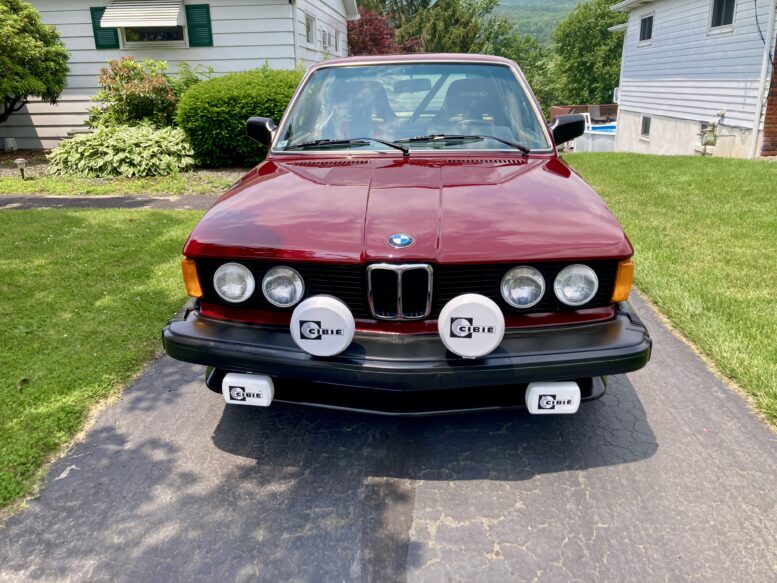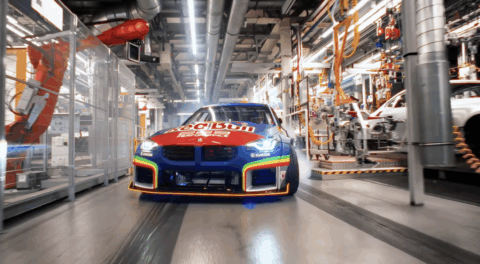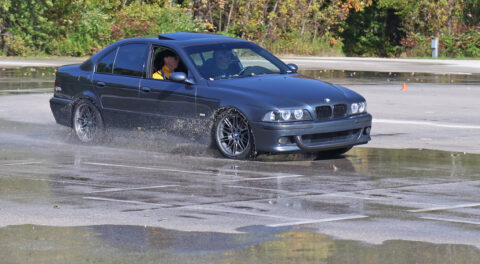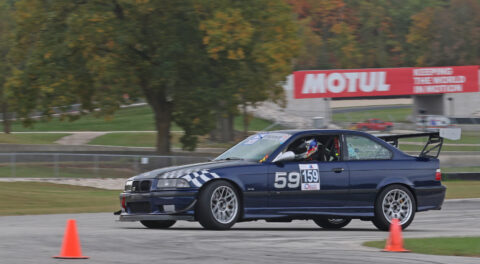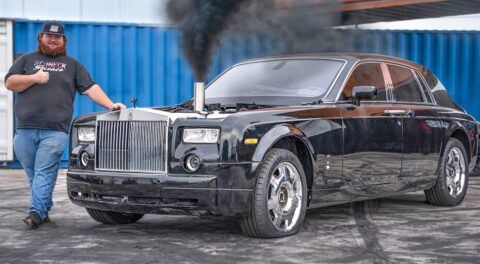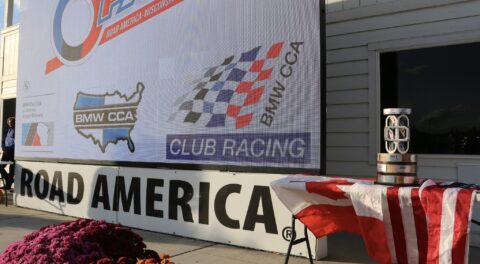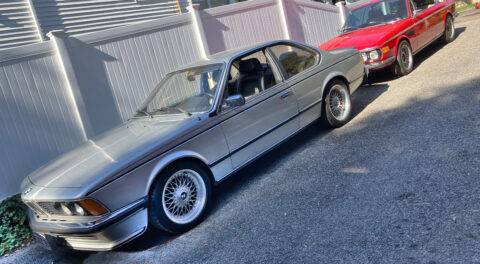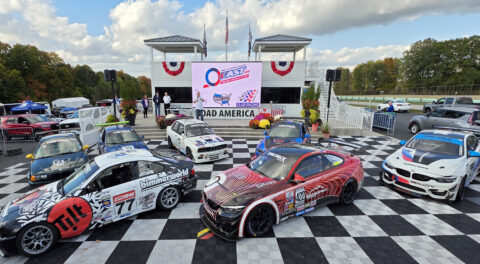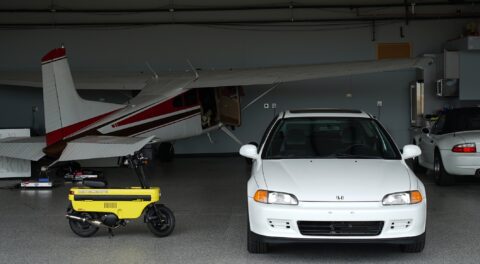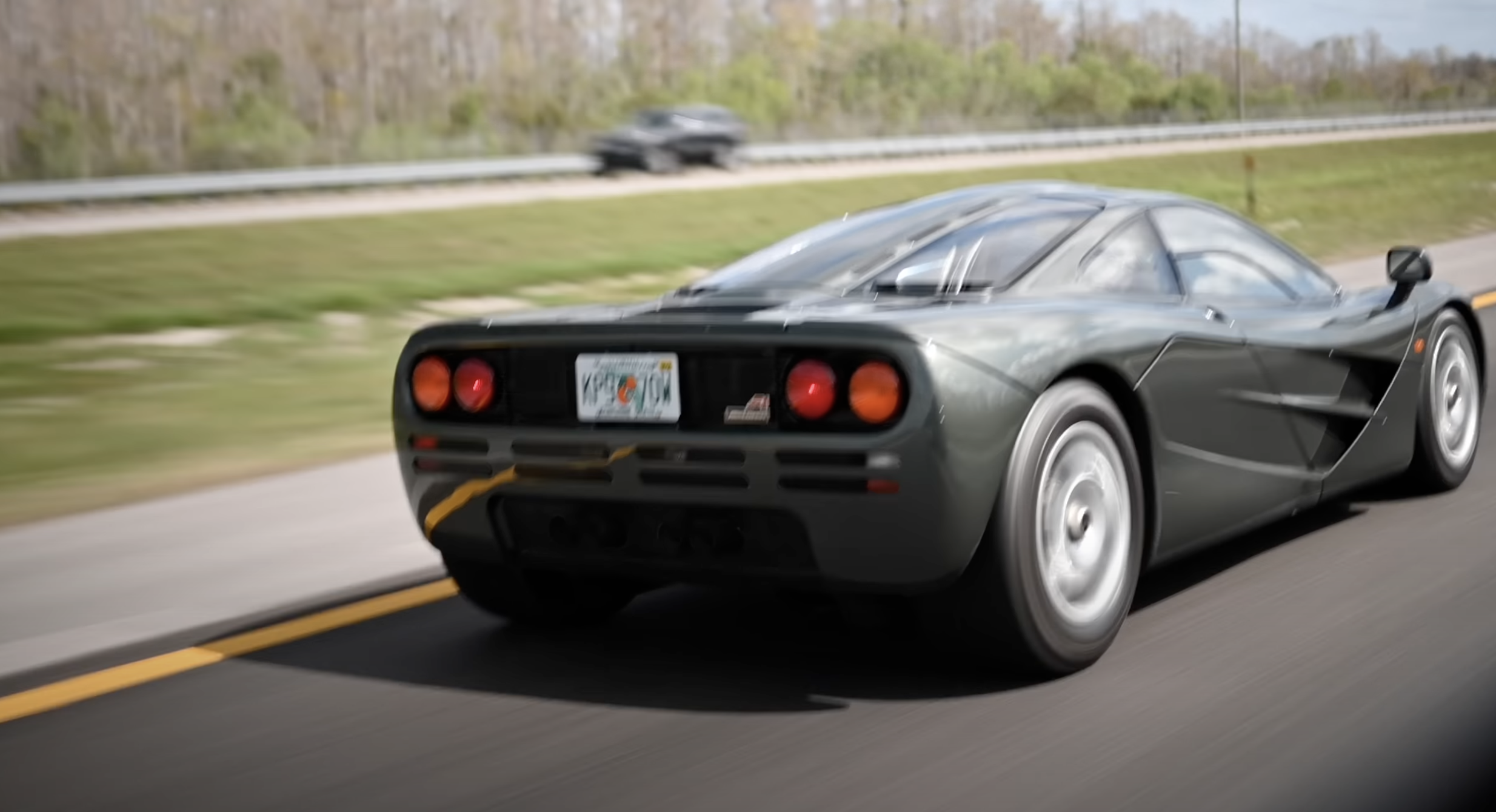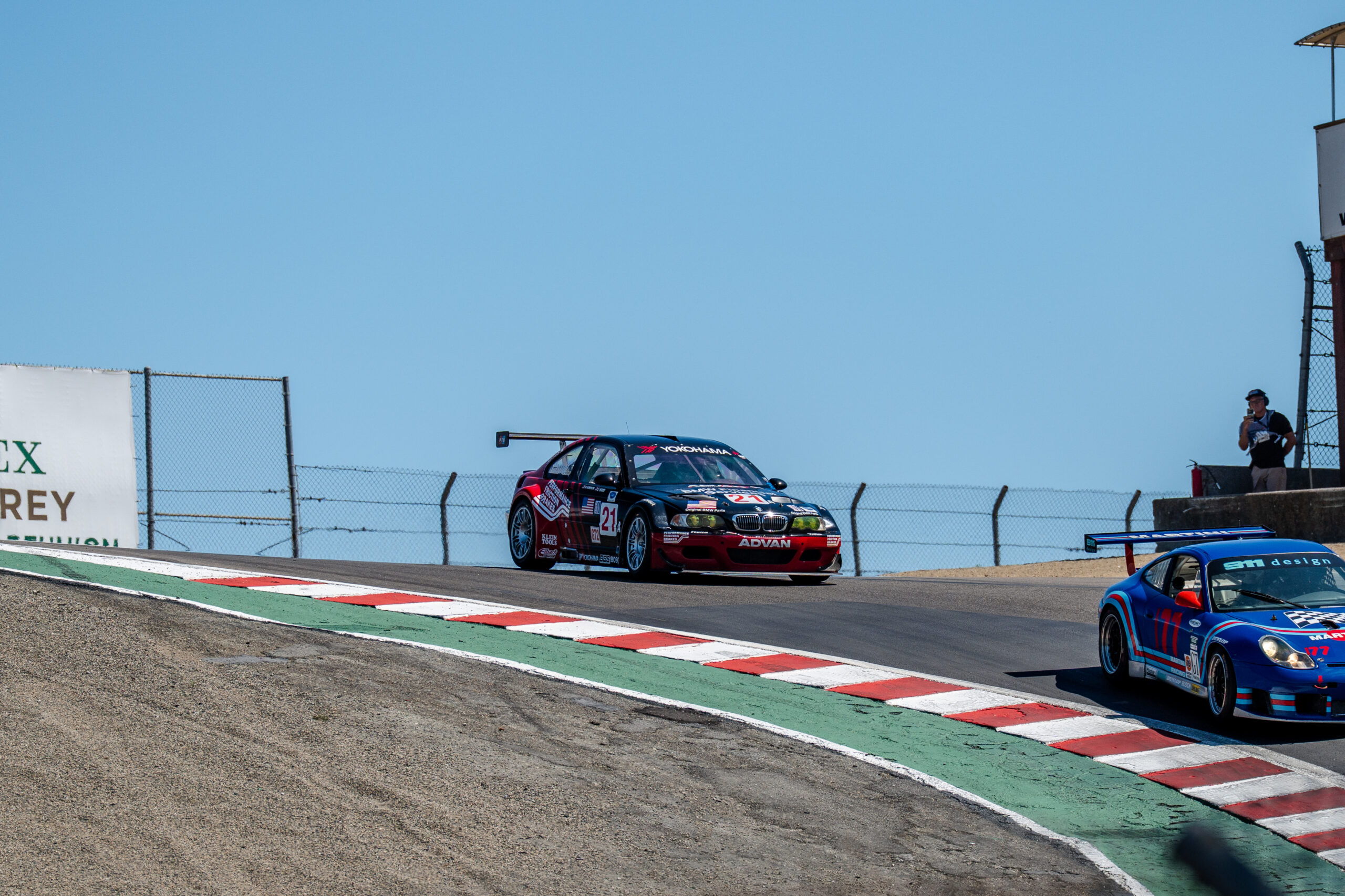About a month and a half ago, I posted the first part of this piece—a quick thumbnail of how, as most of you know, our treasured Roundel Technical Editor and Tech Talk Q&A writer Mike Miller passed away in March from the after-effects of a traumatic brain injury he suffered during a freak accident while working in his garage in 2020. His fiancée and beneficiary Lisa Binder had Mike’s property to deal with, which included his beloved 1977 320i “Hans” that he’d restored over several decades as a rally-themed car, how Lisa contacted Satch Carlson for advice about selling it, and how Satch referred her to me. The car was gorgeous, and was a tribute to both Mike’s meticulousness and his iconoclastic tendencies, but its uniqueness, particularly the roll bar, rear-seat delete, and Corbeau racing buckets and harnesses, made it challenging to value. Further, because Mike submitted all of his receipts annually to his accountant, it appeared that there wasn’t a folder of records for the car.
I went back and forth with Lisa about what to do with Hans. I found an article that Hemmings did on the car in 2011 that included an interview with Mike and was a trove of information. I contacted the author, and he located and sent me Hemmings’ spec sheet on the car that was part of the article. It was from these sources that I learned that the car’s engine was rebuilt with 9.3:1 pistons and a Schrick 284-degree cam, and that it had an unobtanium Metric Mechanic “Ultimate Five-Speed Sport/Overdrive” gearbox with tighter second and third gear ratios and an even-taller-than-usual overdrive 5th gear. Using that information as the basis for a description, I began by floating the car for sale on my Facebook page and that of The Vintage, but as is often the case, there was admiration but no actual traction.
Due to the usual realities of time, space, and dollars, Lisa did need to find a new home for Hans, so my advice to her was to auction it, as that enters you into a process that produces a buyer (whereas advertising it enters you into a process with no clear conclusion). I recommended Bring a Trailer because I have experience with them, and because, despite my and others complaining about their bland “house voice” descriptions, the long wait times, and the nitpicking from people in the peanut gallery who have never bid on a car, it does have a demonstrated track record of bringing high values to cars that are either rare or are viewed as finished products (a particularly nice black-on-black 320i turbo had just sold on BaT for an eye-popping $37k). Mike’s car did have that “finished product” part going for it; the restoration was still beautiful 14 years after it was completed. The question was whether the “product” was too specific to Mike’s vision to cause the kind of competitive bidding needed for a high-value BaT sale.
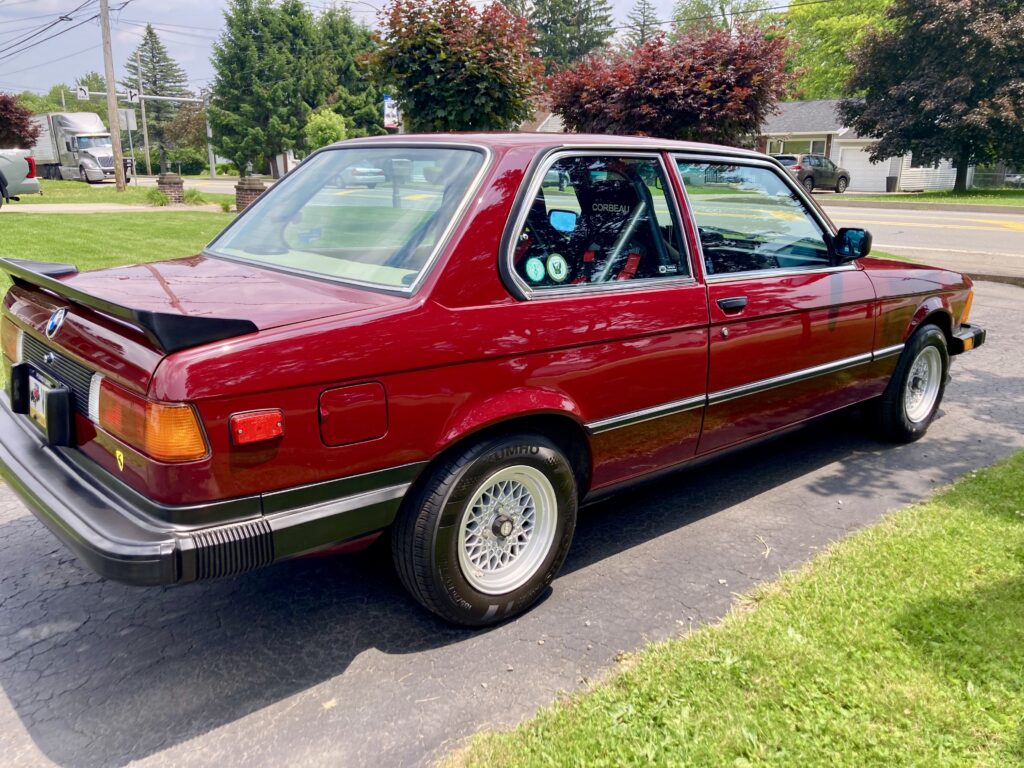
The “finished product” part.
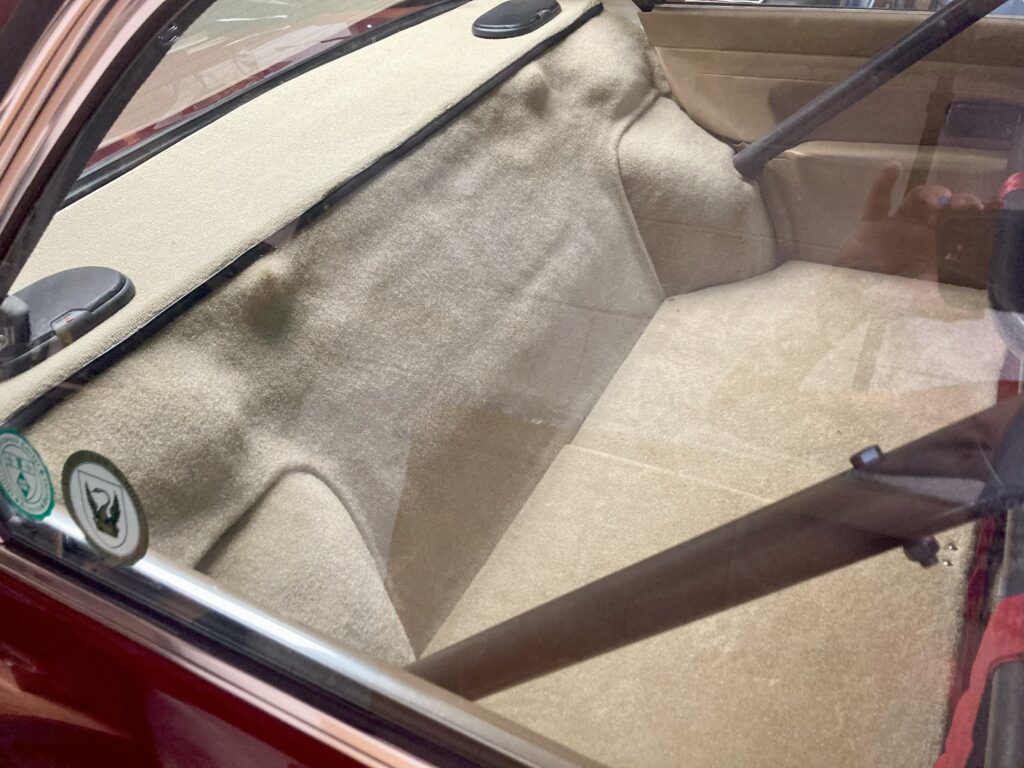
The “perhaps not to everyone’s liking” part.
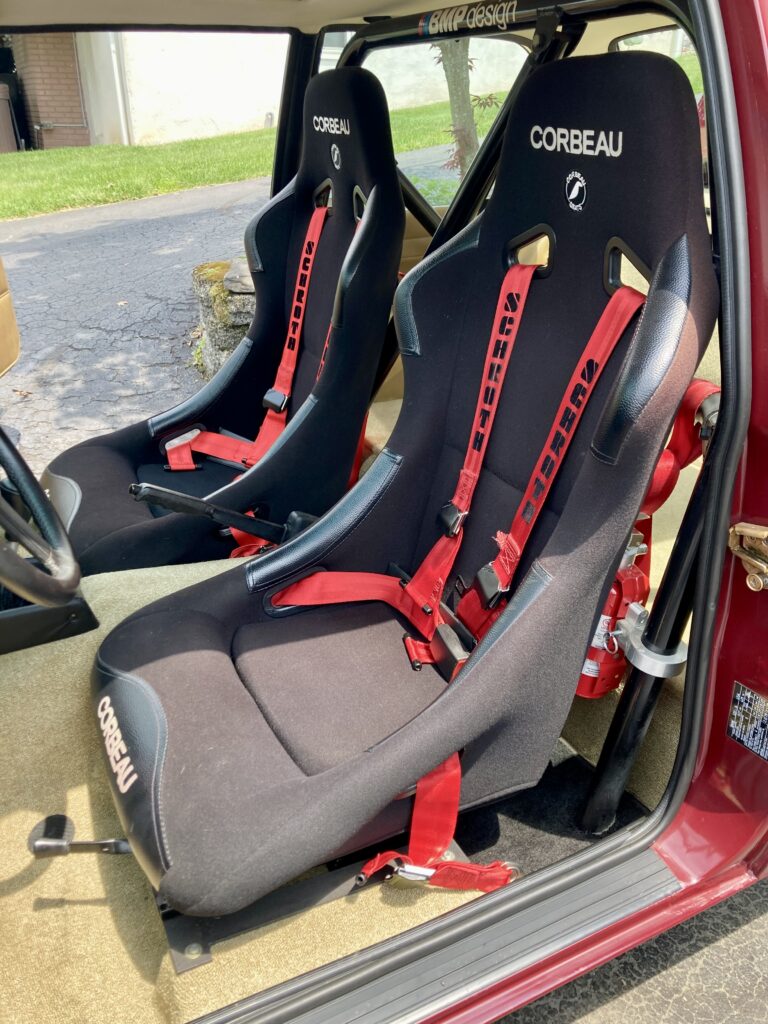
Most folks probably would’ve preferred a set of beige Recaros to the Corbeau buckets and harnesses.
If you haven’t listed a car on BaT, their process is unusual as compared with an auction site like eBay. They first need to accept your car. Their application includes detailing the car’s history, describing any current rust or past bodywork or accident damage, enumerating any modifications and current needs, uploading a detailed set of photos of the car as well as a copy of the title, and stating a reserve price if you want one. Then you wait for them to accept the car. If they do, they come back with a recommended reserve value and a checklist of needed additional information and photos. The reserve is typically negotiable, but not by much. If you accept, there’s then a waiting period during which they craft the auction description. You can voluntarily supply additional photos during this period. When they’ve completed the listing, they send it to you for approval. You can suggest small changes, but they typically don’t budge by much. When you’re satisfied, you hit the “accept” button, pay the $99 listing fee that commits you to advertising the car there and only there, and wait for them to tell you that the auction is scheduled. My experience has been that it’s about three to five weeks from application to the auction going live.
In addition to the car itself being unusual, the situation of Mike having passed, Lisa legally owning the car as his beneficiary but the title still being in Mike’s name (she had the appropriate estate paperwork), the car being at Mike’s house outside Scranton but Lisa living in Florida, and me representing the car but living up in Boston (and not having seen the car in at least a decade and never having driven it) was of some concern to BaT. I assured them that between Lisa’s frequent travels up to Scranton, a tenant who lives in Mike’s house and had been Mike’s caretaker, and my familiarity with the process, we could represent the car honestly and be responsive to all bidders. BaT recommended that one of us be present with the car as the auction closed, which Lisa agreed to. I gave her a punch list of photos and videos to take, including going to a service station and paying them $20 to put the car up on a lift so the undercarriage could be photographed. Perhaps we should’ve paid the $330 for BaT’s professional photo service, but Lisa’s pics and videos were quite credible.
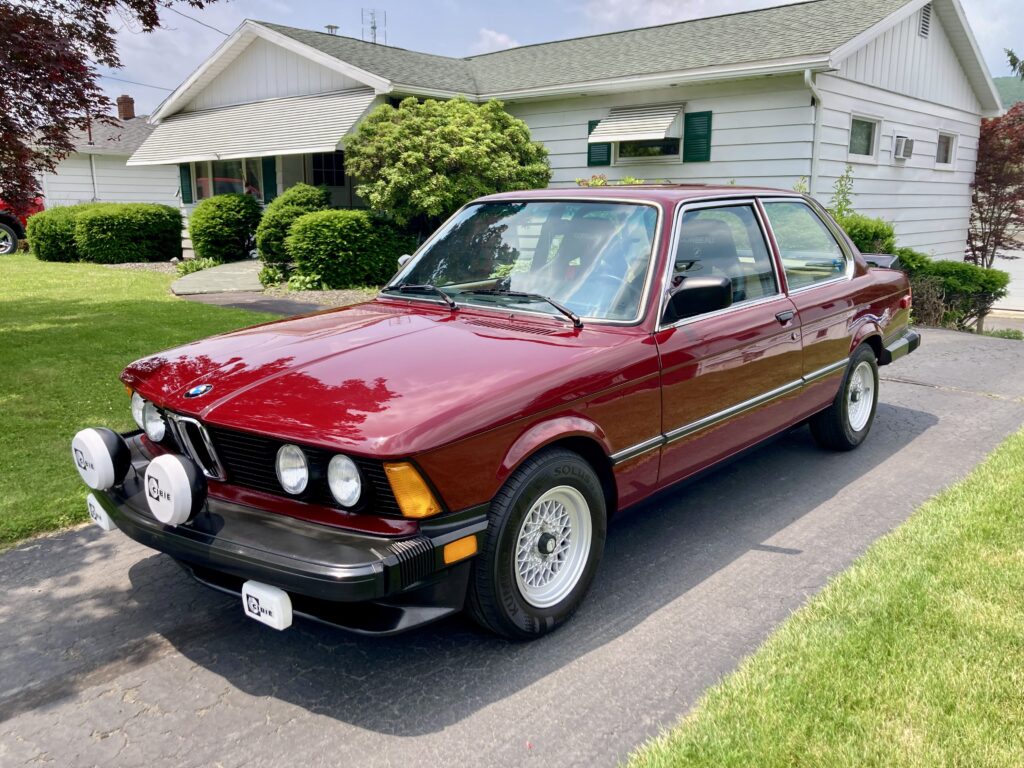
Freshly cleaned and sitting in Mike’s driveway, Hans looked beautiful outside…
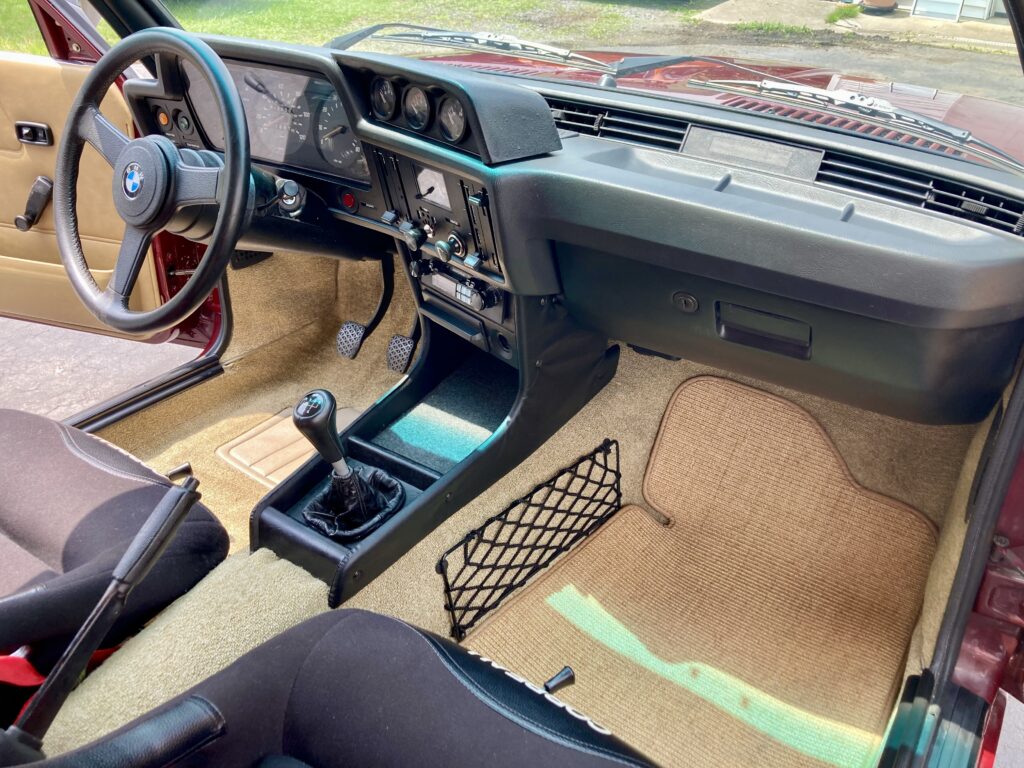
…and in.
Coincidental with the auction was the fact that, months ago, I’d been asked by the CCA Allegheny Chapter to speak at the Friday night kick-off reception for BMW CCA events at the Pittsburgh Vintage Grand Prix (PVGP), and was offered tickets for the weekend. I’m not really a motorsports guy, so I accepted the speaking invite but booked quick-in-and-out flights, coming down late Friday afternoon and flying back out on Saturday morning. But as we moved toward listing Mike’s car, the fact that both it and PVGP were in Pennsylvania made me think that I should synergize them. That is, a BaT auction would be even more credible if I could see and drive the car and shoot my own walk-around and driving videos and post them to the auction. I even began thinking that the thing to do would be to drive the car back to Boston. That way, I could road-trip Hans, which would make for a great story (I’m always in it for the story) and relieve Lisa of the responsibilities of answering questions that required examination of the car as well as handle shipping. However, the fact that Pittsburgh and Scranton are both in PA didn’t make this fall into place. The two cities are five hours apart. There’s an airport in nearby Wilks-Barre, but there didn’t seem to be any easy or inexpensive way to, say, fly into Pittsburgh for my talk, get to Scranton, and either abscond with Hans or video a test-drive in the car and then fly home.
Also in the back of my mind was the issue that, really, the best place for Hans would be at the museum in the BMW CCA Foundation in Greer SC. After all, they got former Roundel editor Yale Rachlin’s car after a benefactor bought it and donated it in 2017, and being part of the car’s induction was emotional and meaningful. However, I felt that I had a fiducial responsibility to Lisa, and that my announcing the car’s availability on my Facebook page, the page for The Vintage, and here on BimmerLife, and then putting it on Bring a Trailer, gave it enough exposure so that if someone else wanted to put together a “Buy it and donate it to the Foundation” effort, they certainly could.
On Monday June 30th, while Lisa was at Mike’s house in Scranton, BaT emailed me the auction acceptance. I sent them a few additional requested items such as a copy of Lisa’s power of attorney document and a close-up of the odometer. However, things hit a snag when BaT recommended a no-reserve auction. Because of the risk associated with this, Lisa engaged several people who had expressed various levels of interest for the car. She and I agreed on a reasonable asking price and a settling price for a private sale, and we waited for things to play out. Unfortunately nothing came of it. I contacted BaT and asked if they were categorically opposed to any reserve. They came back with a reserve price that was low but acceptable to Lisa.
A week later, on Monday July 7th, BaT emailed me the draft auction listing. I was surprised at what a nice job they did. Nowhere did the listing use the “Power is delivered to the rear wheels” phrase for which they’re often ridiculed. Instead, they’d taken my input (much of which relied heavily on the Hemmings article) and crafted an excellent description. I made one suggestion for a very small change. They accepted it. I approved, and paid the $99 listing fee. Lisa asked me how long it would be until the auction started. I told her probably several weeks. She scheduled a flight home.
But then, several hours later, to my stunned surprise, I received an email from BaT saying that the auction was scheduled to begin at 5:44 EST that evening. I immediately called Lisa. She rescheduled her flight to stay with the car for the duration of the auction. I frantically composed what I’d post as the first “Honest Rob’s auction of Mike Miller’s car” comment in the auction. You can see the listing here. Unfortunately, because of the Monday-to-Monday timing, the live auction didn’t make it into either of my last two pieces here on BimmerLife.
Then we waited and watched. I asked an acquaintance who had actually driven Hans to post to the auction describing what the car was like, and he did. I also asked Lisa to chime in, describing Mike’s relationship with Hans and how he gave it anything it needed (and, she added, many things it probably didn’t). She wrote a lovely, personal, and very human post. Over the next week, we read dozens of lovely heartfelt comments about Mike, his tireless commitment to helping CCA members, and the passion that went into the car. One old friend of Mike’s who was present for much of the build added that the Hans had a very rare E21 close-ratio steering rack.
To keep interested parties engaged, I employed a strategy someone else taught me about BaT auctions: Whenever you as a seller post new photos, it generates an email to everyone who is watching the auction. So I pored over Mike’s Facebook page and extracted every photo I could find of the car. There turned out to be many that were taken during restoration. Unfortunately, most were 640×480, so they needed to be run through a tool to double or triple the image resolution in order for BaT to accept them. In addition, Lisa sorted through Mike’s envelopes of tax receipts, pulled out the ones that appeared to be for the 320i, and scanned them, giving us a good-faith attempt at service records. I hoped that, in addition to simply generating emails, these photos would personalize the connection to Mike, as well as show that the car is in essentially the same condition now as it was when the restoration was completed in 2011.
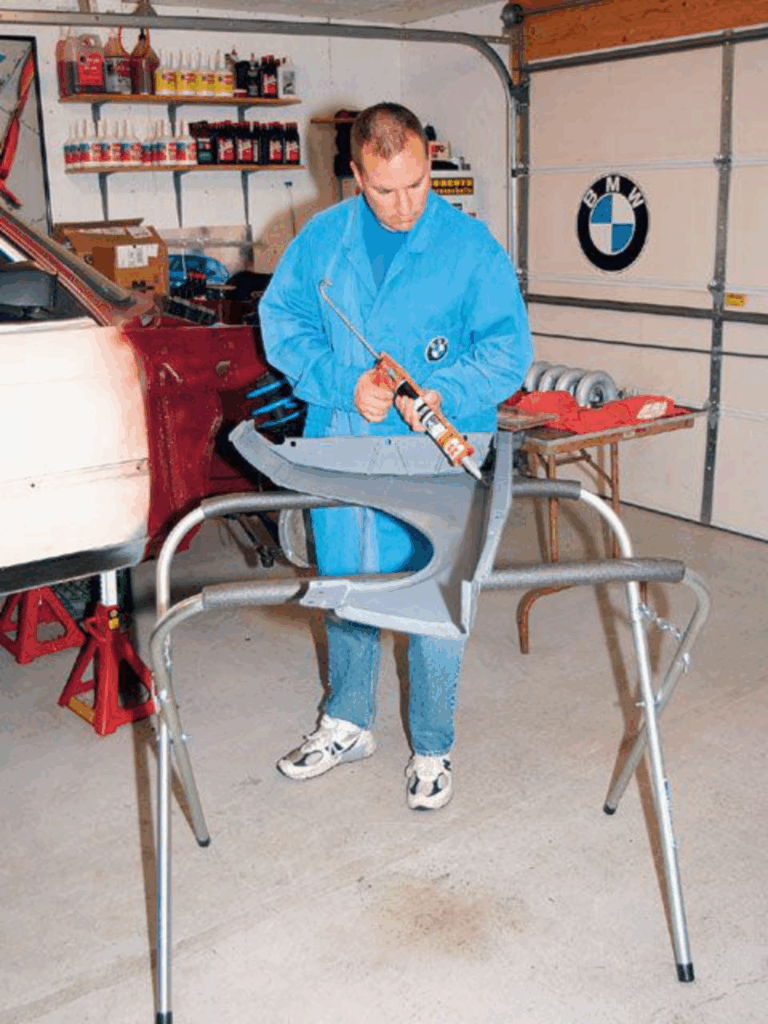
Mike applying the seam sealer before bolting on a fender.
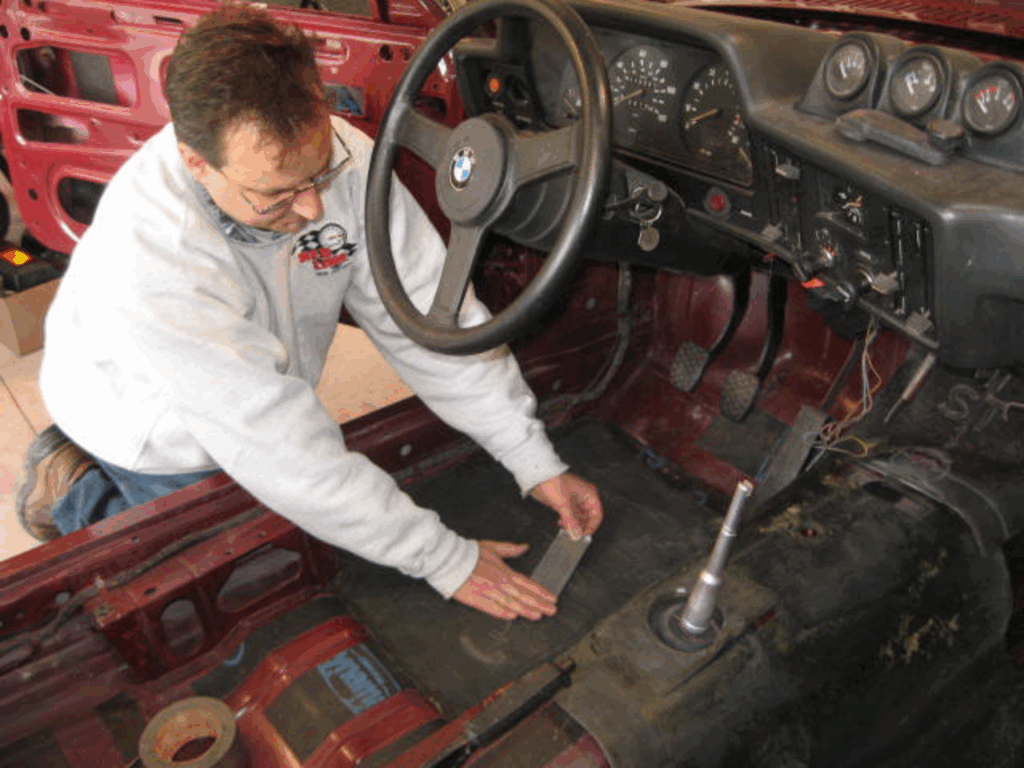
Mike putting the interior back together.
Then a few things happened that increased my stress level. The first was that the fellow from Hemmings who’d written the 2011 article expressed disappointment that, considering the history that Mike had with them and the help they’d given in supplying technical information about the car, I’d listed the car with BaT instead of Hemmings. I realized that he was right, and that I’d made a fairly substantial breach of professional etiquette. When I’d asked for rights to use their photos, it only had been for the first piece here on BimmerLife and for the “float” of the car on my Facebook page. Fortunately I hadn’t used any of the Hemmings pics in the BaT listing. I apologized to him for my myopia in listing the car on BaT and not considering Hemmings, but in my defense, I said that I hadn’t considered Hagerty (for whom I also write) either.
Next, the fellow who’d hired me to speak at the PVGP became very excited about the possibility of bringing Hans to PVGP and having it be the center of BMW CCA attention there. He offered the new owner complimentary tickets for weekend events, and even began arrangements for the car to be displayed in the hotel lobby. While I loved his energy and his outside-the-box thinking, and while I deeply appreciated that he was coming from the same desire for a posthumous show of appreciation for Mike that I was, suddenly I was working with him to craft a post for the BaT auction that accurately portrayed his offer as just that—an offer, not something that sounded like a requirement that might actually drive away a bidder.
Most of the action in BaT auctions is usually at the end, but even knowing that, the bidding seemed sluggish. There were several comments about how the BMW CCA Foundation museum would be the best destination for the car. Near closing time, the auction finally hit the criminally-reasonable reserve, and inched up a bit with competitive bidding, but despite 8800 views and 503 watchers, the car’s Mike Miller provenance, the in-as-restored-in-2011 condition, the hot engine, and the unobtanium gearbox and steering box, it didn’t bring what I and Lisa had hoped. A few post-sale comments agreed that the sale price drastically undervalued the car. Perhaps professional photos and videos might have nudged things up a bit, but I think that ultimately the rally-tribute style of the car, particularly the roll bar, the deleted rear seats, the buckets, and the auxiliary gas tank, was just a little too extreme for mainstream tastes (even Mike, in the Hemmings piece, said that if he had to do it over again, he would’ve left out the roll bar and seat-delete). And the nearly 200,000 miles on the car probably didn’t help things. But c’est la vie.
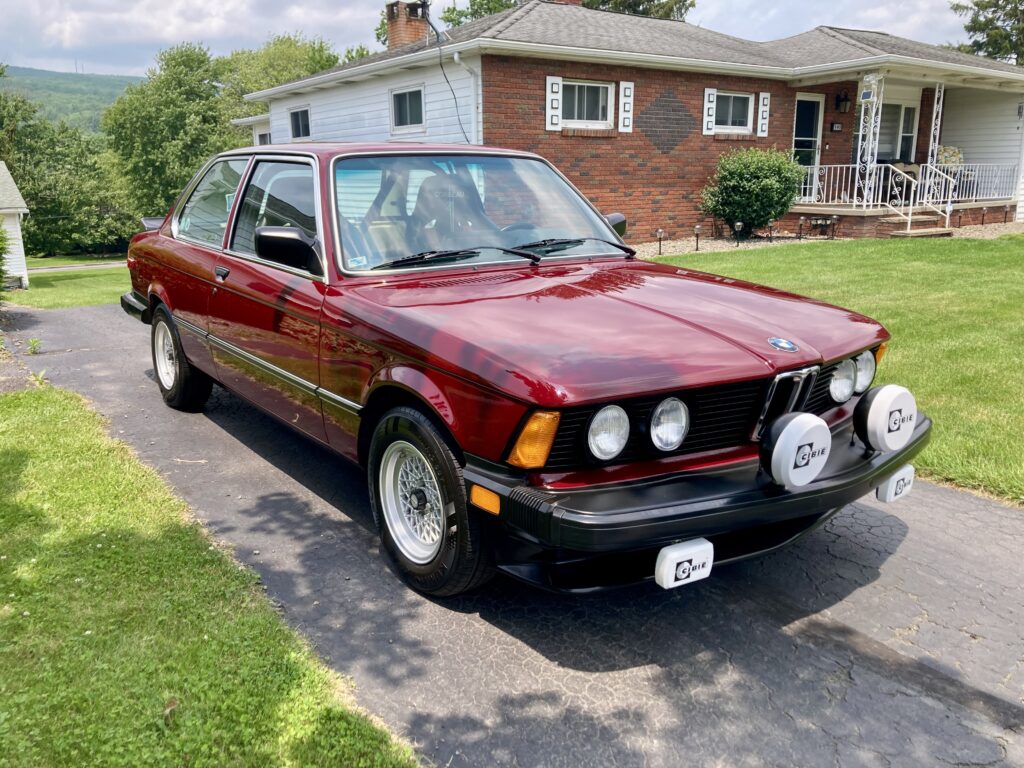
A steal at $14,007.
As Lisa was unfamiliar with the BaT process, I first called her, then called the buyer (who had bid on cars but never won, so he also was unfamiliar with the process), and walked them through the steps. The buyer was a very easy-going affable man, a 74-year-old surgeon who was mainly an Alfa guy but had BMWs back in the day, had been a CCA member, and knew who Mike and I were. Although BaT offers “verified checkout” (essentially an escrow service), I recommended that they do the human-to-human thing and talk with each other over the phone, establish trust, then do a simultaneous mail transfer of paper check and paper documents.
Then, after I got off the phone with the buyer, something happened that kicked me in the gut. I saw that a text had come in. I read it, and my jaw dropped. It was from someone I know on the board of trustees of the BMW CCA Foundation, saying that he had tried to submit a winning bid on the car right at the end, but something hiccupped and the bid didn’t get in. He asked if I knew what the buyer’s intent was with the car, because if he didn’t want to keep it, he might be able to make a little bit of quick cash by selling it to this fellow for donation to the Foundation. I was so jarred by the fact that if it weren’t for a last-minute bobbled bid, the car might have gone where both Mike and Lisa would’ve wanted it, though I didn’t mention any of this to Lisa. I told all this, though, to the buyer—who said that he already had three offers to buy the car but was keeping it—and did an exchange of contact info between him and the Foundation gentleman.
Hans didn’t make it to the PVGP. The Alleghany CCA chapter and the buyer had a good-faith conversation about trying to make it happen, but the logistics were just a bit too daunting.
I really don’t know what I could’ve done differently to have established a better outcome, but I was left with the feeling that, despite a ton of effort, I somehow should’ve handled it better. My conversations with the buyer made me feel like he will be a caring owner, but the idea that Hans was a hiccupped-internet-connection away from winding up at the CCA Foundation Museum next to Yale’s tii haunts me. My friend at the Foundation told me “It took us a while to get Yale’s car. We can play the long game with this one.” Here’s hoping that that’s where it winds up. Mike would really like that.
—Rob Siegel
____________________________________
Rob’s latest book, The Best of The Hack Mechanic, is available here on Amazon, as are his seven other books, including Just Needs a Recharge: The Hack Mechanic Guide to Vintage Air Conditioning. Signed copies can be ordered directly from Rob here.
Tags: bidding Foundation Museum Miller
